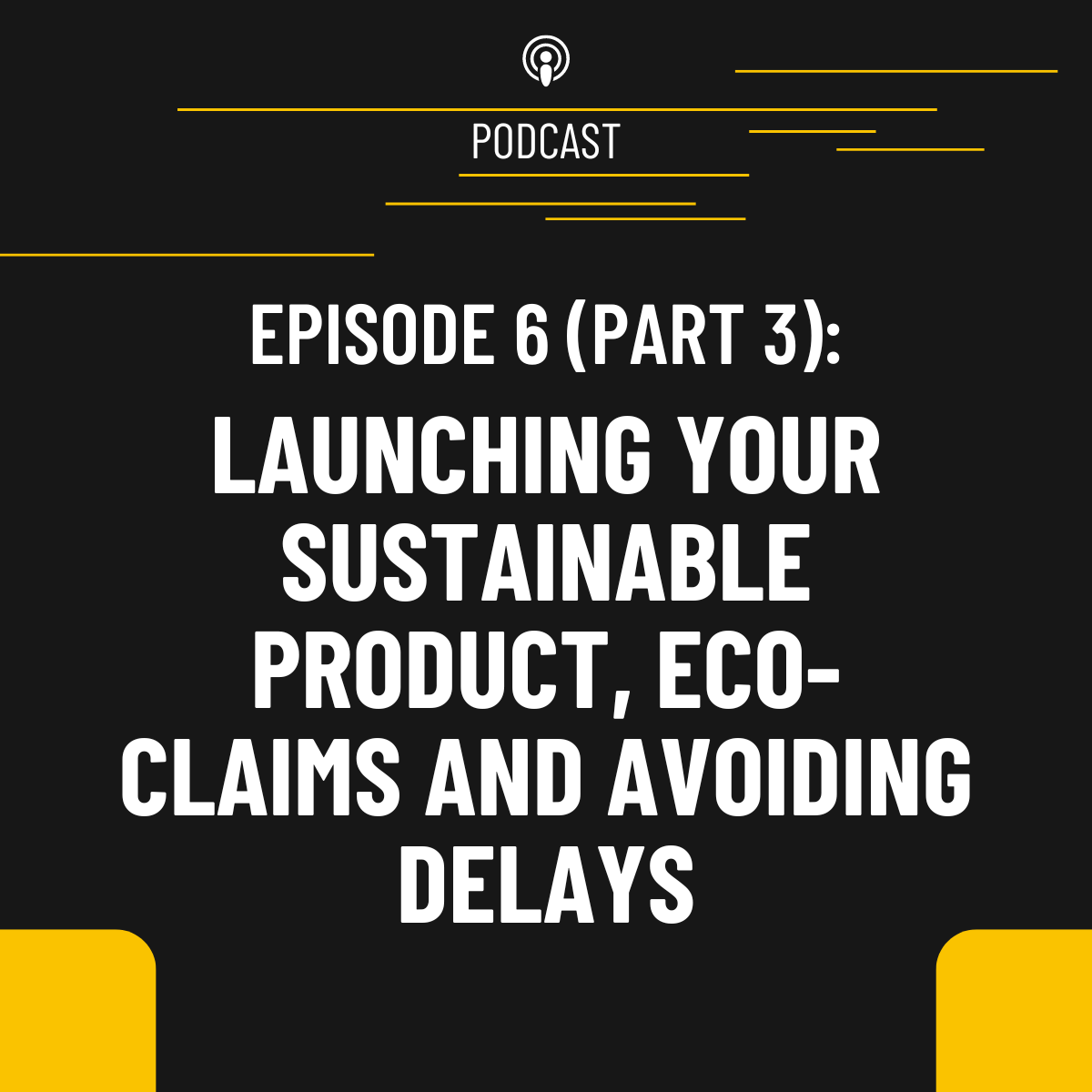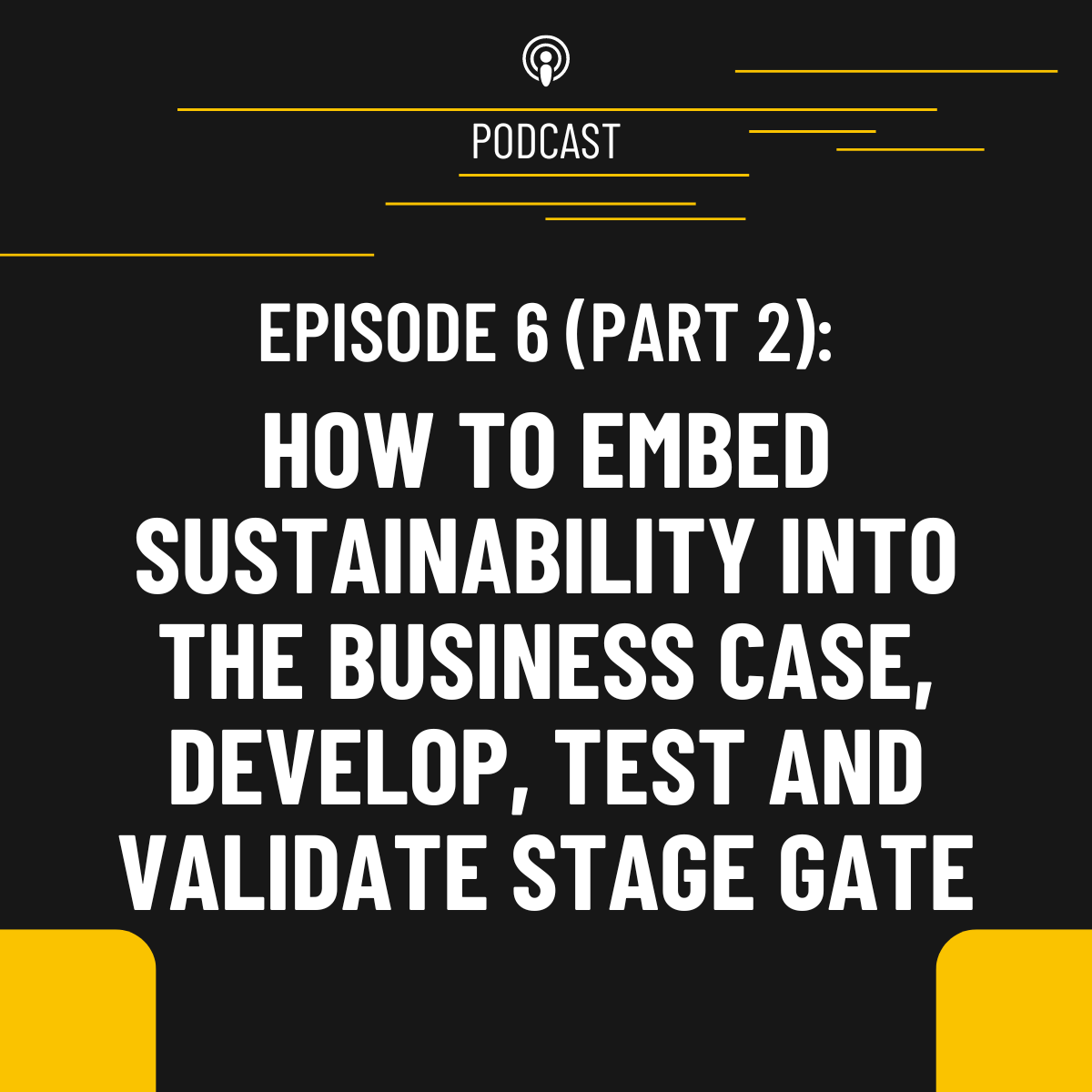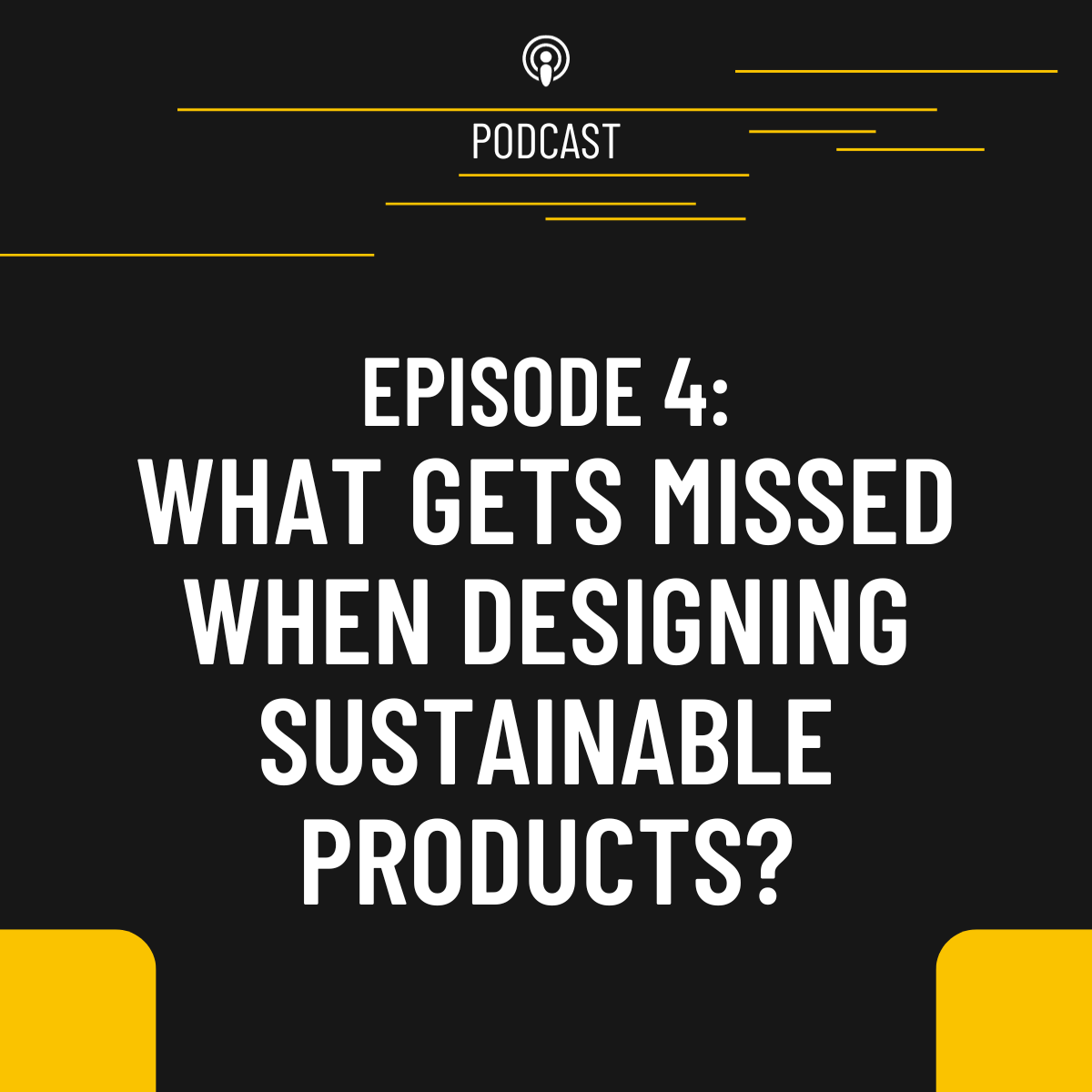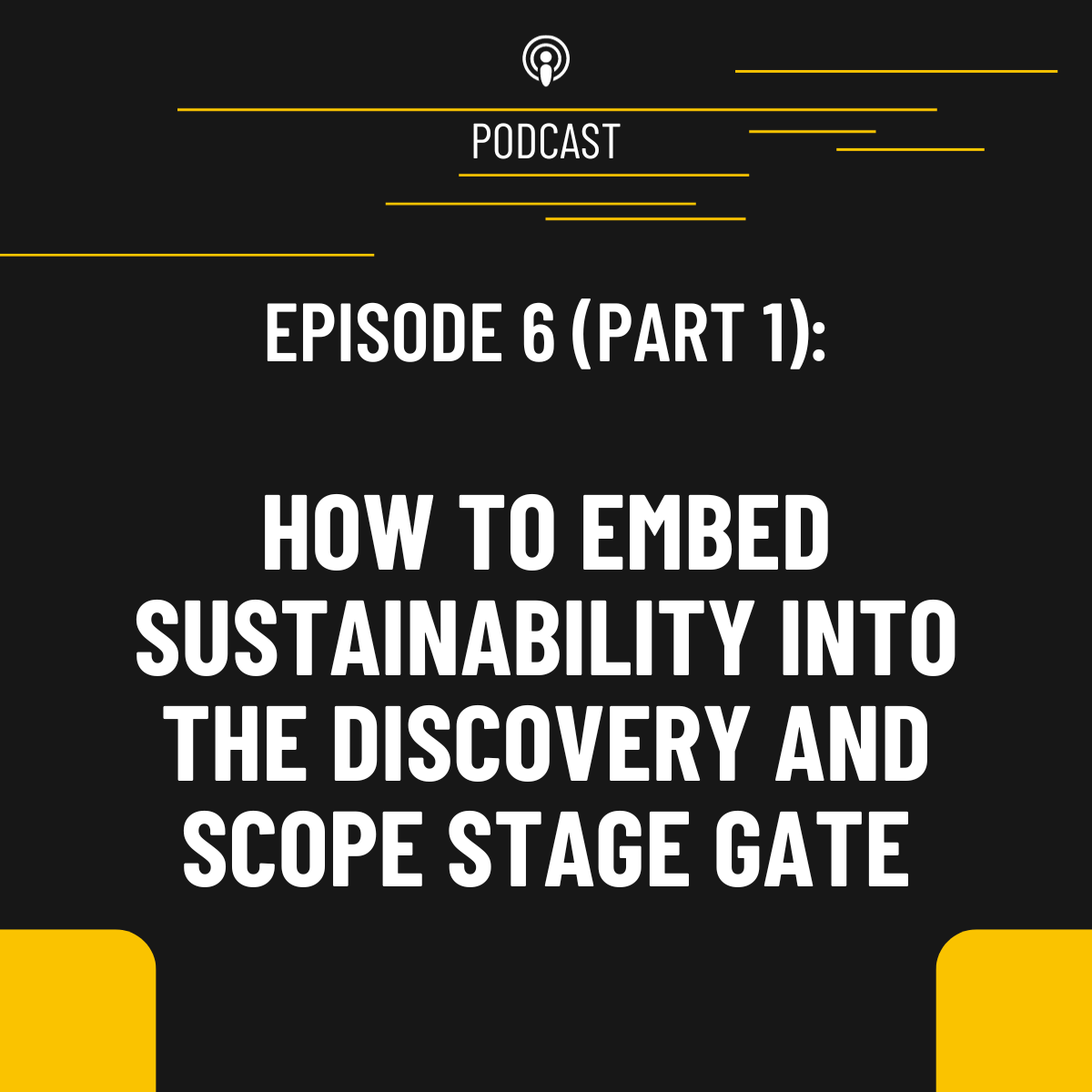Show Notes
In the final part of a three-part series on embedding sustainability into the stage gate process, Neil, Jim and Shelley discuss the launch phase of a product. From voluntary reporting to confidential disclosures to avoiding delays, there are a number of important final hurdles to clear as you approach the finish line.
Listen back to parts 1 and 2 of episode 6 to follow the stage gate journey from beginning to end.
In this Episode
Shelley: The launch phase is when you are getting ready to take your product to market. Neil let's start with you. What kinds of things does a product manager need to consider at this phase? [00:04]
- Neil: The first thing to consider is this is the combination of all the effort that you have put in until now. You've got a great innovation, whether it's a product or it applies to an entire portfolio. Maybe you've created new packaging, or more product efficiency. Or across the portfolio, maybe you've invested in green steel, or switched materials to something more sustainable across several products. [00:37]
- There are different ways to communicate this, but the framing is around whether you are B2B or B2C. In B2B your customer is very technical, and they use this information to decide whether to buy from you. They are more educated on this topic than a typical B2C. Therefore, the messaging on these products is to be catered to that customer.
- That’s the most basic thing to keep in mind, and it's more so for sustainability because not everybody wants to know whether it's sustainable or not. What sells this more sustainable product is the goal. It's not about telling the customer that it is more sustainable.
- Also, different markets geographically are more perceptive to different kinds of messages. In Germany, for example, people are looking for things that have claims of environmental sustainability, whereas in other regions this is meant to be assumed.
- Some require you to make a claim about the sustainability value of your product. CBAM is a recent one that is specifically related to the carbon content of products that you import into the European Union. Here you do not decide how to communicate because you send this information to the government and the lower the carbon value, the less tax you pay. There's a consequence of using accurate data. You could use average information and pay full price, or you can be as specific as you can and if there is a saving compared to the benchmark, then you pay less. If you're importing in the hundreds of millions, that's a significant tax saving.
- In other regimes, you're looking at safety of the materials that you've put into your product, whether its REACH regulations in Europe or Prop 65 in the United States. These are things that you need to get in order before you go to launch.
- Another consideration is voluntary reporting. You have type one, two and three environmental claims. You have labels like Blue Angel here in Germany, but there are other similar agencies who will assess your product and give you a stamp. Type two declarations are self declarations where you can write a report, make a claim, and have it validated by a third party. Type three claims are environmental product declarations - an agency principally tells you how to calculate environmental performance or the characteristics of your product and you share this depending on whether you are a B2B or B2C company.
- Type one claims are typically suited to B2C products, whereas type three claims or EPDs are more related to B2B products. And then type two, which is a self declaration, is neither here nor there; you could use it for both. For example, on Microsoft's website you can see the environmental characteristics of the laptop you are buying. This is a highly successful model that many companies are using to help sell products. And it's not an environmental label.
- It is important that when you are making a public claim, it is verified. Last year, Europe launched anti greenwashing regulation with hefty fines, so it's very important to follow the guidance information provided by the government.
- Third is confidential disclosures that you don't make public. You sign an NDA with your B2B customer, and you share information. BASF, for example, does this. Last year they created environmental footprints that are specific to the product for a large portion of their portfolio, and they only provide this information to their B2B customers, which helps their customers with their own disclosures and make better decisions about how they're designing their products.
- There are lots of tools available to product managers that I described to position the product and the value created through the eco design activities in the previous stage gates in the best possible way. It is super important to leverage this. This is not the place to go cheap or to take shortcuts. Make sure that it is clear and used as a differentiator to sell more of your product. The goal is not to talk about great stuff, it is to sell more of this great stuff.
- Jim: Launch is when you've done the analysis, collected the data, and you put a stake in the ground about what you are going to communicate to your specific consumer and why. You have to make those decisions before Launch; you cannot wait to the very end. [07:37]
- During discovery and the business plan stage you've got an initial perspective. You might know you sell to a B2B – like a homebox store - and the consumer who buys from that B2B is not concerned. Maybe they just want the power drill that can go faster or run for 8 hours.
- Know upfront the specific market standpoint, so when you reach Launch, you know what the messages are, the data is documented, and analysis is done. If you need an external review, that's done. You can't wait a week or month before launch and then try to do all that.
- I’ve been in the sustainability/lifecycle business for 30 years, and too many times we get a call from someone who says ‘I'm launching this product in a month. Can you give me a LCA to do ABC?” It's just not possible. Maybe some new artificial intelligence might be able to do it, but in my experience you can't. So, from the beginning of the stage gate process, it's important to look at the three or four areas you think you can make a positive sustainability statement and then be able to collect the data.
- If you're using an LCA, you must follow ISO 14040 and 14044 standards. And there's FTC in North America and the EU has eco design and sustainable product requirements coming out. You need to know these are out there.
- Neil: There's one more thing to consider in the B2G in Europe, which I think is going to proliferate everywhere – it’s the kind of things where you can't put a product on the market unless you disclose information. There's ESPA, for example, which is a new European regulation, which brings the product passport into context. Every product on the market will have a QR code or a reference to an ID where you need to deliver sustainability information or environmental product information. [10:43]
- In three to five years all these products will be activated and regulated. If you've got half a million products, it’s not something that happens in a month. As you build new products, embed a system of evaluating the environmental consequence of making a product in a particular way, in a particular design, in a particular location and documenting this and building this inventory of information, because this takes a lot of time.
- A lot of companies have set science-based initiative targets. The first years when you set the target, it's all great. But after year three, people are looking for how are you doing on these targets, and the targets are harder to meet by just buying carbon credits and stuff like that.
- Management comes to departments in companies and asks can we build products or a product portfolio that has lower carbon impact? Or they'll go to procurement, and ask can we buy materials that have a lower carbon impact? Either way, this is your job and at the end of the day, this is specific to the product you're making.
- Tons of companies started preparing for this five years ago: inventorizing all the activities and impacts. I think you will not be able to put products on the market in the next five years unless you can make claims about environmental performance. If you combine this with things like CBAM, the coarser the information, the higher the cost.
- Jim: Once you've launched you think the job is done, but that's not the case. When you think about the funnel we talked about, its narrow at launch, but after Launch it begins to expand again because you almost do another discovery and scoping stage, because now you're looking at market changes like government requirements, customer expectations, improvement in availability of technologies or data and tools. That's from a market standpoint. [14:10]
- The second thing is procurement. When you launch the product, your suppliers not only have to provide the parts and material based on the agreement, but they must make sure they maintain environmental and social performance requirements that you put into their contract.
- The third piece is what happens at the end of life and in the example of a battery, who's going to have responsibility for collecting, recovering, reuse, and to disassembly? As a product manager you have stakeholder relationships, not just for launch but over the post launch period. Monitor and work with them to make sure they follow through and do their roles.
- We talked to a product manager the other day and they said when they go to senior managers right now, the two things they are concerned about are 1) end of life, and 2) depending on whether it's B2B, B2C, or B2G, the senior managers are committed to sustainability as a corporation for overall performance. You must be able to translate for a particular customer or market. The interaction with senior managers is changing drastically in the last few years.
- Neil: Launch is a hectic thing. Enablement is required. Partners need to be notified. There's a long time to push the message out through the different channels. [18:07]
- The context of what happens to the product after you've sold it has become more popular in the last five years or more because of the kind of regulations that we're seeing and the kind of visibility that you have for products that are creating harm after their end of life. I think it's about making sure you give yourself enough time to prepare for these things. The sooner you start the better.
- Just so you know, if you wanted to do a comparative study – let’s say you're making laptops and you want to say my laptop is greener than the competition - there are rules about what you're allowed to do and you need to have a study according to an ISO standard. This then needs to be verified and certified and a verification can take as long as twelve months.
- I've often seen product managers say we built something amazing. We know it's better than the competition, but we can't claim it because we can't get the verification done in time. making claims, make sure you have a good amount of time in advance to make the preparations.
- Jim: We've been approached within a month or two of product launch by the marketing people who want to go public, and they’ve already communicated to senior managers. At the time I’d say you can't do that because we don't have the information to make those claims. But if you did the study earlier and you find out months before launch that you can't make those claims, the marketing people haven't shared that with senior managers. You can manage that and ask what can we say? [20:16]
Shelley: I'd like to hear from both of you, one or two final ideas about how a product manager can be prepared not to miss any of these important steps, so they don't find themselves too late in the launch phase to make an environmental claim that they want to or something else that is important for them to think about in this phase. [21:34]
- Neil: The process of eco design and eco innovation starts right up front. Don't slack on those early stages because that's what's going to help you now. You don't want to be greenwashing, which is a thing of the past. Make sure you're working on quantifying the thesis you develop early on and keep validating. There are always going to be changes. But make sure you are keeping that consistent model, that digital thread, of how this information changes. This is one thing that I would recommend any product manager to invest in. [21:58]
- We learned this the hard way and we went from CAD designs to PLM systems and PLM systems to the concept of a digital thread. It is for exactly this. You want to document this as early as possible so that you don't have to discover all of this at the end.
- The second, is make sure you know the kind of claims there are, and because you're developing hypotheses, what kind of claims you can make. You can talk to specialists and sometimes even within your own company. Finding this out during the hypothesis phase is super important because it'll help you prepare and, for example, get a verifier in advance. We have customers where they've waited eight months to find a verifier that had the time to certify their results.
- Jim: It’s the realization that launch is just the beginning of the product's lifecycle. And that means that the company - the product manager and his or her extended team - must make sure they can identify changes and if those changes will have an impact on their product. If so, they collaborate to deal with it quickly. It's not rocket science, just a recommitment to teaming with your trade association, supply chain procurement managers, or your extended product management team. But you've got to do it in a way that’s ongoing and you can gather that information, understand it, and be prepared to make the changes necessary so you can stay competitive in the marketplace. [24:07]
- Neil: It's a bit of a tangent, but I see this a bit as debt. You take on a debt to invest in a product and you want to see the realization of that investment. In the engineering world there is technical debt: these kinds of shortcuts you take in order to get the product to market. And I see a third kind which is evolving now, which is sustainability debt: all the shortcuts you take in terms of what you need to do to make your product sustainable. This accumulates, and you have to think of it as sustainability debt because people are counting this information at a company level. So maybe you'll get away with it this year. You sell fewer green products, but you'll get more product out and get some revenue. As you take a product to market, you say it's done now. But keep in mind what debt you've taken on when you take that product to market. [25:36]
Links to Things We talk about
- The Coordinated Activities on the Safety of Products (CASP) - https://op.europa.eu/en/publication-detail/-/publication/130df18a-4e6f-11ec-91ac-01aa75ed71a1/language-en
- Carbon border adjustment mechanism - https://taxation-customs.ec.europa.eu/carbon-border-adjustment-mechanism_en
- Proposition 65, California - https://oehha.ca.gov/proposition-65
- REACH, European Chemicals Agency https://echa.europa.eu/regulations/reach/understanding-reach
- Blue Angel, Germany - https://www.blauer-engel.de/en
- Environmental Product Declarations (EPDs) - https://www.environdec.com/all-about-epds/the-epd
- Federal Trade Commission (FTC) Green Guides - https://www.ftc.gov/news-events/topics/truth-advertising/green-guides
Who’s talking?
To read about who you are listening to, visit fivelifestofifty.com and click on our bios.
We want to hear from you
Do you have a story about how you are using what you heard?
Is there a question you would like answered?
We want to know! Write to us at [email protected].








